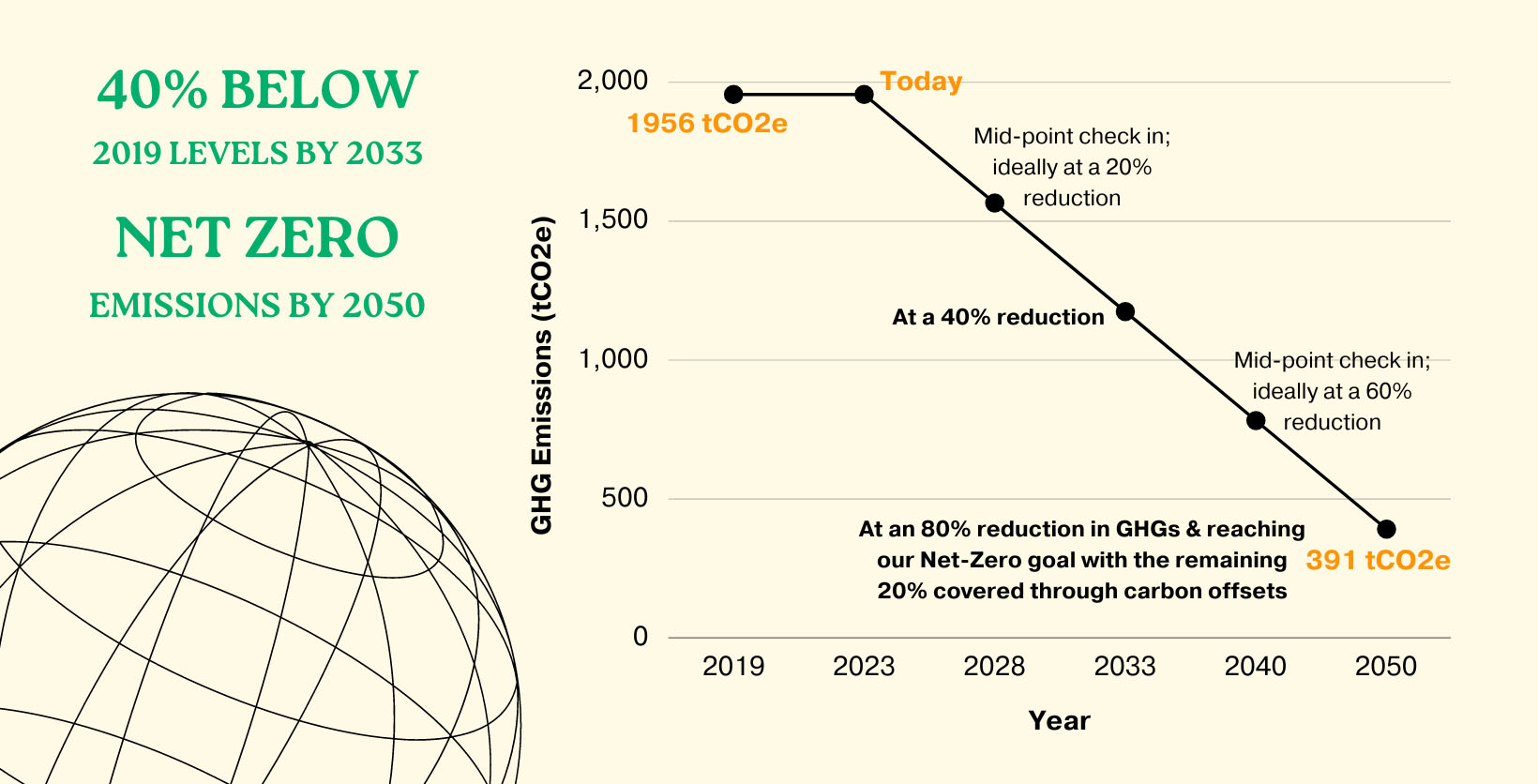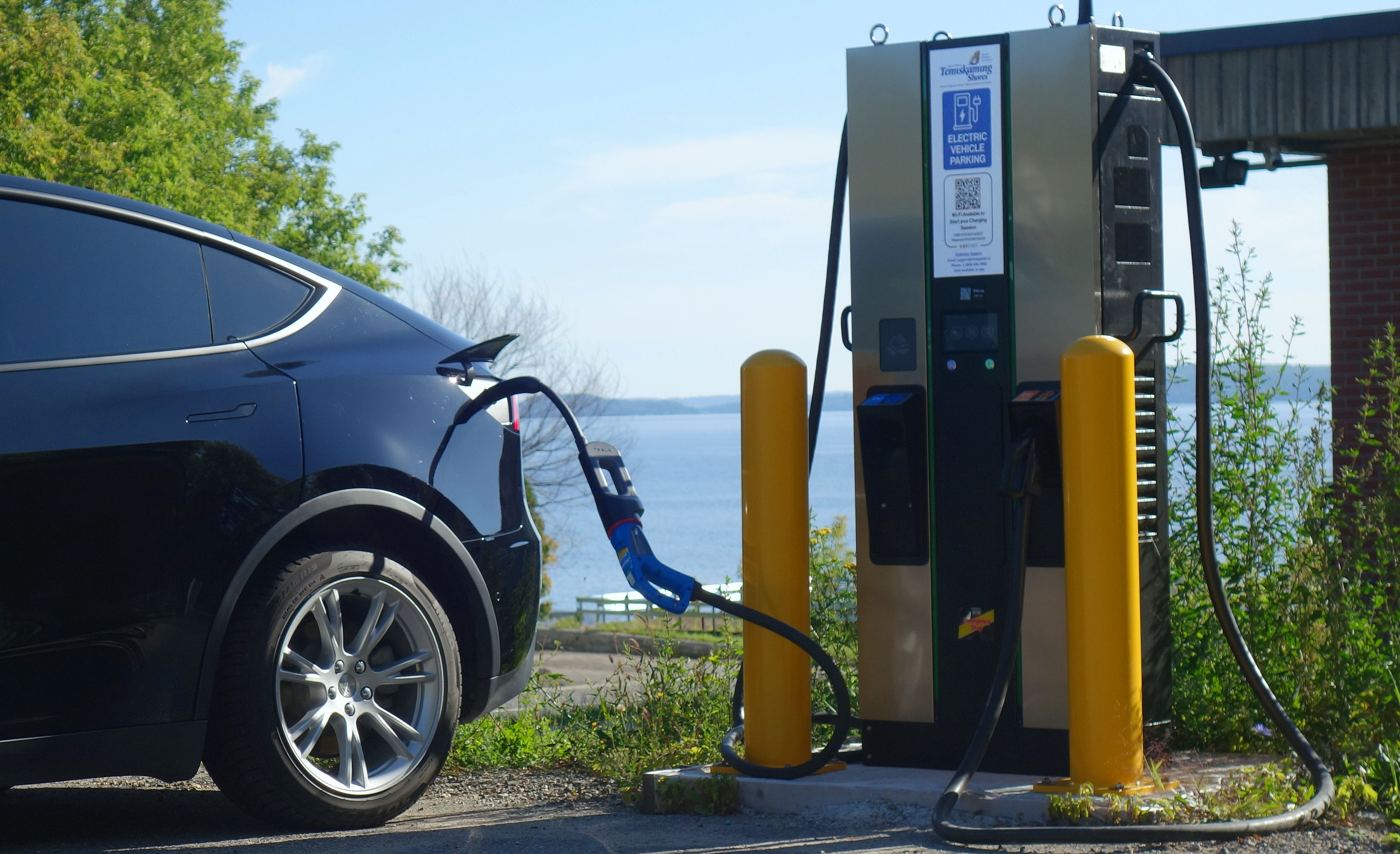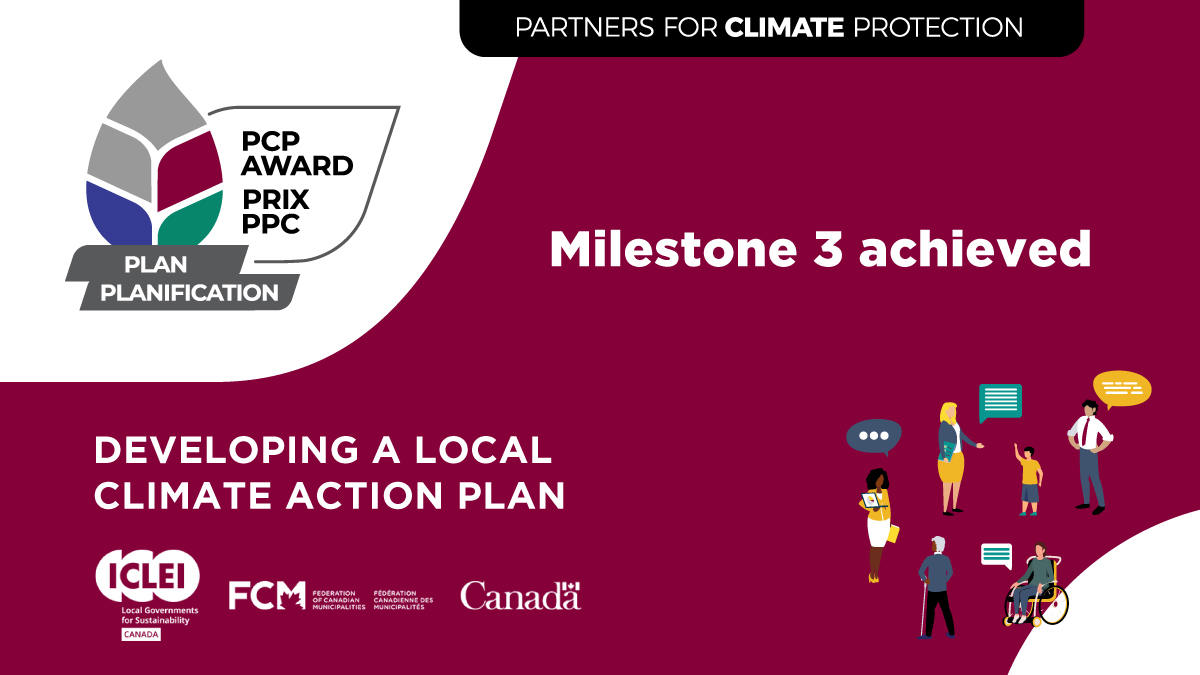Taking Action on Greenhouse Gas Reduction
The City of Temiskaming Shores is committed to tackling climate change through ambitious goals to reduce greenhouse gas (GHG) emissions. These targets, set as part of the Partners for Climate Protection (PCP) program, aim to significantly decrease our environmental impact.
Our Targets
We're working towards a 40% reduction in municipal GHG emissions by 2033 and achieving net-zero emissions by 2050. These goals are dynamic and will be continually evaluated to ensure they remain achievable.

Prioritizing Action
We're focusing on reducing emissions from municipal operations first, where our ability to make changes is most significant. This approach includes adopting measures like transitioning to electric vehicles, using low-carbon fuels, and enhancing the energy efficiency of buildings.
Steps to Success
Our 2019 baseline GHG inventory analysis indicates that we can achieve a 23% reduction from municipal operations with minimal changes. We're confident that with the right strategies, we can achieve this reduction. New green technologies will further contribute to reaching our targets.
Partners for a Greener Future
We joined the Partners for Climate Protection program in 2018, signifying our commitment to emission reductions. Our completed inventory, targets, and action plan set a solid foundation and starting point for our goals. These goals are tracked through the program's milestones, taking place over a ten year period.
Engaging the Community
The City actively sought public input in 2020. The feedback received led to the establishment of the Climate Change Committee, comprising of council members and the public, aiming to collaboratively develop more ambitious reduction targets. This collaborative approach is key to meaningful change.
The Path Forward
Our commitment to climate action is supported by our comprehensive Corporate GHG Reduction Plan. This plan encompasses a review of our baseline inventory, potential reduction opportunities, a timeline for implementation, and a monitoring strategy. It serves as a roadmap to guide us toward our ambitious targets.
Looking Ahead
We're excited to continue this journey, setting targets aligned with federal goals and leveraging innovative strategies to create a sustainable future for the City of Temiskaming Shores. Our commitment, collaboration, and data-driven approach will guide us toward a greener tomorrow!
| Media Release - April 5, 2023 |
|
City of Temiskaming Shores Adopts a Net Zero Corporate GHG Reduction Target Temiskaming Shores, ON – The City of Temiskaming Shores has adopted ambitious corporate greenhouse gas (GHG) reduction targets in order to meet the requirements of Milestone 2 of the Partners for Climate Protection program. The targets, recommended by the City’s Climate Change Committee, include a GHG emission reduction target for municipal operations of 40% below 2019 levels by 2033 and to have net zero GHG emissions from municipal operations by 2050. Thorough analysis of the baseline GHG inventory completed in November 2022 helped the City to uncover some potential GHG reduction opportunities that were used to guide discussions around setting ambitious and achievable GHG reduction targets. “Setting emission reduction targets to become net zero by 2050 is an important milestone for Temiskaming Shores as we address climate change,” said Mayor Jeff Laferriere. “Our targets are ambitious but achievable and will help to ensure we’re a Northern Ontario climate leader.” In order to match the urgency of climate change, the City decided on the interim target of a 40% reduction with the understanding that any emission reductions accomplished now have a greater positive impact on the climate compared to the same actions taken in the future. The selected targets are well aligned with federal climate goals of net zero by 2050 and are similar to the targets set by many other municipalities, including Thunder Bay, Sudbury and Sault Ste. Marie. The City will monitor these targets and re-evaluate as the dates approach. If over or underachieving there will be opportunities to adjust these targets to ensure they remain achievable. Next steps for the City involve the creation of a detailed corporate GHG reduction plan that will map out a pathway to meeting these targets. With a comprehensive plan for reducing corporate GHG emissions, the City will then shift to also focus on approaches to reduce emissions from the broader community sectors. Partners for Climate Protection Media Contact Abbigail Shillinglaw, Energy and Climate Change Coordinator
|
| Corporate Greenhouse Gas Reduction Plan |
A Sustainable Path AheadFocused Approach: Our corporate emissions breakdown reveals that the fleet (49.9%) and buildings (41.6%) drive emissions most. These sectors are key targets for reduction efforts due to their carbon-intensive fuel use. Other sectors like water facilities and streetlights rely on low-carbon electricity. Leading the Change: We've pinpointed three core reduction programs to pave the way towards net-zero by 2050 - electrification, biodiesel fuel switching, and building decarbonization. These initiatives could yield an estimated 23% overall reduction. They're strategically chosen to target high-emission sectors, offer straightforward implementation, and cause minimal disruption to daily operations. Achieving Goals within Reach: The feasibility of our reduction targets depends on available budget and staff resources. Despite challenges like high costs, we're identifying funding opportunities and expecting savings from reduced energy bills and operating expenses. Over time, the investment in emission reduction pays off financially. Light-duty Fleet ElectrificationThis program considers the transition to all electric vehicles (EVs) in the City’s light-duty fleet over the span of 5 years. EVs present an initial cost challenge, but they offer long-term savings in operation and maintenance. This program will cut emissions, estimating reductions based on vehicle types and mileage. Funding and Savings Strategy: Although EVs are pricier upfront, we're strategizing funding. Our fleet replacement plan will be adjusted, gradually increasing allocations. Grants, loans, and potential sources like the Federation of Canadian Municipalities and Government programs are being explored. We anticipate cost savings over time, reinvesting them to cover future EV expenses. Impressive Results: This plan leads to remarkable emission reductions. Starting from a baseline of 59.72 tCO2e in year 0, by year 5, the program aims to bring emissions down to 2.35 tCO2e – a 96% reduction. Although this directly impacts only 6% of our total corporate vehicle emissions, it's a crucial step in preparing for a sustainable fleet future. Action Timeline: We're set to launch this program in 2024, planning to complete it by 2029. As the light-duty fleet goes electric, we'll then explore EV opportunities for the medium and heavy-duty fleet, further advancing our green initiatives. Fuel Switching to BiodieselsIn 2019, the city's diesel consumption reached nearly 297,000 liters, leading to over 803 tons of carbon dioxide equivalent (tCO2e) emissions. Biodiesel presents a more environmentally friendly alternative without needing extensive infrastructure changes. Why Biodiesel? Most diesel vehicles can run on biodiesel, although there may be blend level limitations that require checking with manufacturers. It's not a permanent solution but offers a lower-carbon option until we can pursue more sustainable alternatives like electrification in the future. Strategy and Potential Benefits: Following a similar approach to Toronto's successful biodiesel program, we plan to use different biodiesel blends throughout the year. This method resulted in 8.4%-12% annual GHG reduction in Toronto. We expect to see a 7%-10% reduction in emissions with a manageable expense within our budget. Initiative Timeline
This approach ensures a seamless transition, while also exploring eco-friendly options like electrification and optimization. Building Decarbonization ProjectsOur ambitious building decarbonization initiative aims to reduce emissions from city structures. Selection Strategy: Based on GHG inventory, we've prioritized 8 buildings (Don Shepherdson Memorial Arena, Shelley Herbert-Shea Memorial Arena, Waterfront Pool and Fitness Centre, City Hall, Riverside Place, Dymond Complex, New Liskeard Public Works Main Garage, and Haileybury Public Works Garage). These buildings are the most GHG intensive and offer the greatest opportunities for decarbonization. Decarbonization Study: In 2024, we'll conduct a study to understand how best to reduce emissions in these buildings, aiming for a 50% reduction in 10 years and an 80% reduction in 20 years. We expect a corresponding 15% and 23% reduction from our overall corporate baseline in 10 and 20 years, respectively. Funding and Savings Plan: Funding is being pursued through the Green Municipal Fund's Community Building Retrofit Program. The cost savings from implemented measures could be used for further projects, aligning improvements with regular maintenance, without financial strain. Expected Outcomes: The expected GHG reductions are 292 tCO2e in 10 years and 467 tCO2e in 20 years. This investment not only creates more efficient buildings but contributes to energy savings and a reduced carbon footprint. Action Timeline
The building decarbonization effort is a key part of Temiskaming Shores' sustainable future, offering not only a pathway to greener buildings but also contributing significantly to the city's overall reduction in GHG emissions. By investing in this project now, we're setting ourselves up for long-term success in reducing emissions and saving costs. |
| Residential Programs |
Natural Resources CanadaCanada Greener Homes Grant - Aiming to curb greenhouse gas emissions, the Canada Greener Homes Grant focuses on making Canadian residences more energy efficient. With up to 700,000 grants offering funding of up to $5,000, homeowners can implement energy-efficient retrofits, including improved insulation, heat pumps, and renewable energy systems to contribute to a greener future. (no longer accepting new applicants) Canada Greener Homes Interest-free Loan - Enhance your home's energy efficiency and comfort with the Canada Greener Homes Loan. This interest-free financing complements the Canada Greener Homes Grant, supporting major recommended retrofits. The loan, up to $40,000, comes with a 10-year repayment term and is available to eligible homeowners who have completed a pre-retrofit evaluation after April 1, 2020. (no longer accepting new applicants) Oil to Heat Pump Affordability Program - Is your home heated by oil? Is your household at or below the median household after-tax income? Homeowners who answer “yes” may qualify to receive an upfront payment of up to $10,000 under the Oil to Heat Pump Affordability Program to switch from oil heating to new, energy efficient heat pumps. The Oil to Heat Pump Affordability Program helps Canadian homeowners who are currently heating their homes with oil to transition to electric cold climate air source heat pumps. Making the switch can help you save thousands of dollars on your heating bills every year and help reduce greenhouse gas emissions. Save on EnergyEnergy Affordability Program - Tailored for eligible homeowners, tenants, and social and/or assisted housing providers, this initiative aims to boost energy efficiency in homes and buildings. It features a comprehensive in-home energy assessment, professional installation of energy-saving measures, and expert guidance on additional steps to maximize energy savings. EnbridgeHome Efficiency Rebate Plus - Unlock thousands in incentives as a homeowner. Benefit from energy-saving upgrades like home insulation, windows and doors, heat pumps and renewable energy systems. Eligible Enbridge customers who use natural gas to heat their homes will benefit from enhanced rebates, while also offsetting the cost of their EnerGuide home evaluation with additional rebates. (no longer accepting new applicants) Home Winterproofing Program - Qualify for this program and experience up to 30% energy savings through professional installation of new insulation and draft-proofing measures. Lower your energy bills while enhancing home comfort. Affordable Multi-Family Housing Program - Invest in efficient equipment to cut building energy costs and boost resident comfort. Get incentives up to $200,000 through the custom program when you upgrade equipment and improve energy efficiency. Smart Thermostat - Make energy savings effortless by installing a Smart Thermostat. This technology utilizes sensors and Wi-Fi to ensure comfort when you're home and efficiency when you're away. Benefit from automatic energy-saving adjustments and convenient maintenance alerts, including filter changes for your furnace. When you invest in an eligible Smart Thermostat, you can claim a $75 incentive. Verify eligibility criteria for more details. Hydro OneUltra-Low Overnight Price Plan (ULO) - Try the Hydro One rate calculator to see if you’d be better off financially by making a switch to Tiered pricing or Ultra-Low Overnight pricing. Customers that use more electricity at night, including shift workers and those that electrically heat their home or charge their electric vehicle, could save up to $90 per year by shifting demand to the ultra-low overnight rate period when province-wide electricity demand is lower. Residential Reliability Improvement Program (RRI) - This program enhances power reliability in select neighbourhoods by installing Tesla Powerwall batteries in eligible homes. These batteries store energy and provide backup power during outages, improving home energy resilience. Installation and maintenance are free for participants, with the system managed by MPOWER Energy Solutions, a third-party contractor, and owned/operated by Hydro One for five years. Electric Vehicle IncentivesZero-Emission Vehicles (iZEV) Program - Discover your path to energy savings and reduced greenhouse gas emissions. Moving to clean zero-emission vehicles (ZEVs) can have a higher upfront cost initially, but the iZEV Program's incentives make it more affordable. By making cleaner transportation accessible, this incentive promotes environmentally friendly vehicle choices. Ontario Energy BoardOntario Electricity Support Program (OESP) - This program lowers electricity bills for lower-income households. It provides a monthly credit to eligible customers based on household income and household size. The OESP credits are applied directly to eligible customers’ bills. Consumer InformationOntario Energy Board - Explore an array of resources, including tools, publications, videos, and tips, on the Ontario Energy Board (OEB) website. Uncover insights designed for individuals and organizations alike, offering a deeper understanding of the energy landscape in Ontario. As the regulator of the province's energy sector, the OEB ensures a level playing field by overseeing energy distribution, pricing, and efficiency. This commitment ensures fairness, transparency, consumer protection, and sustainability within the energy market. |
| Impacts of Climate Change |
What to ExpectClimate change is becoming more noticeable, and understanding its effects on Temiskaming Shores is vital for planning. This data helps us prepare for adaptation and mitigation strategies. Local Climate Data Source: We gathered climate data from the Climate Atlas of Canada, showing historical trends and projections. These forecasts are based on a "business-as-usual" scenario, reflecting changes without action. Temperature Shifts
Precipitation Changes
Environmental Impact
These climate shifts, based on a "worst-case" scenario, require action. While longer summers and milder winters may sound appealing, they pose significant challenges. Understanding these changes is crucial for preparing our region against the threats of more intense storms, forest fires, flooding, and ecosystem disruptions. By acknowledging these projected impacts, we can collaborate towards a resilient future for Temiskaming Shores. |
| Climate Change Adaptation |
Embracing Climate ResilienceClimate change adaptation means getting ready for and adjusting to shifts in our environment. By being ready, we can manage the effects of climate change and bolster our ability to bounce back. There are several actions you can embrace to safeguard yourself and your loved ones. Prepare for Emergencies: With our evolving climate, expect more frequent extreme weather events. Stay ready by: Stay Safe in Changing Temperatures: As temperatures rise, it's essential to stay informed about heat and cold advisories. Follow the provided guidelines to protect yourself during extreme weather. Keep an eye on alerts for severe storms to ensure your family's readiness. Pay attention to the UV index, which indicates UVB ray intensity. Whenever the index is 3 or higher, take sun protection measures to safeguard your skin. Monitor Air Quality: Increased wildfires in the region release significant amounts of smoke and pollutants into the air. Poor air quality can have adverse effects on human health, exacerbating respiratory and cardiovascular conditions. Stay informed by checking air quality updates in your area and take proactive steps to help protect your health and well-being when air quality is poor. Flood Protection: Shielding your home from floods is crucial. Clear out eavestroughs, extend downspouts, and maintain open storm drains. In your basement, elevate valuables in waterproof containers, inspect your sump pump, and ensure floor drains stay unblocked. These steps secure your home against potential flooding. Monitor Wildfire: Use this interactive fire map which provides a forest fire danger rating as calculated by over 130 weather stations across Ontario's Fire Region. This changes throughout the day to reflect up to date weather information. |
| Electric Vehicle Charging Stations |
The Future is ElectricWithin our Greenhouse Gas Reduction Plan, transitioning to low-carbon transportation stands out as a pivotal strategy for curbing community-wide emissions, aligning with our climate targets. The transition to electric vehicles (EVs) brings economic benefits for individuals, businesses, and the City, while also fostering sustainability. Anticipate more charging stations in the next year as we work towards meeting the needs of current and future EV owners. Current EV charging locations within Temiskaming Shores: Temiskaming Shores EVStart Charging Station
Ivy Charging Station
Electric Circuit Charging Station
Wilson Chevrolet Buick GMC Charging Station
 |
| Partners for Climate Protection Program |
A Path Towards a Better FutureThe City of Temiskaming Shores is a member of the Partners for Climate Protection (PCP) program. Led by ICLEI – Local Governments for Sustainability and the Federation of Canadian Municipalities, PCP empowers municipalities to create positive change by reducing local emissions. The program's 5-step Milestone Framework guides cities in making impactful changes:
Aligned with the Intergovernmental Panel on Climate Change (IPCC), PCP helps municipalities achieve ambitious goals. It's user-friendly, free, and offers resources like the PCP Secretariat, an online hub, and the Milestone Tool. By simplifying and encouraging climate action, the PCP program enables Canadian cities to play a vital role in combating climate change. |
| Energy Consumption & Greenhouse Gas Emissions |
Energy Management PlanThe Ministry of Energy passed Ontario Regulation 25/23 under the Electricity Act, 1998, that requires Ontario's Broader Public Sector (BPS) to demonstrate the leadership role government plays in energy conservation. The regulation provides the Ontario government and public agencies with valuable information on how energy is used within each sector, allowing organizations to benchmark their facilities to similar facilities. Subsection 25.35.2(3) of the Electricity Act, 1998, and Section 5 of O. Reg 25/23, requires public agencies to prepare and publish the following documents:
Annual Reports
|
| What You Can Do |
Eco TipsReady to make a positive environmental impact but not sure where to start? Here's how you, as a resident, can play a vital role in taking climate action and embracing sustainability. Reduce Energy Usage: Unplug devices when not in use, switch to LED bulbs, and adjust your thermostat to save energy and lower emissions. Conserve Water: Fix leaks promptly, use a timer for showers, and collect rainwater for plants to reduce water consumption. Cut Down on Waste: Embrace recycling, composting, and reducing single-use plastics. Bring reusable bags, bottles, and containers when you're out and about. Opt for Sustainable Transport: Choose walking, biking, carpooling, or public transportation whenever possible to reduce carbon emissions from vehicles. Consider switching to an electric vehicle. Support Local and Eco-Friendly Products: Buy local produce, choose products with minimal packaging, and opt for eco-friendly cleaning and personal care items. Plant Trees and Greens: Enhance your surroundings by planting native trees and plants. They absorb carbon dioxide and provide essential habitats. Participate in Community Efforts: Join local clean-up events, recycling drives, and workshops to connect with like-minded individuals and amplify your impact. Save on Water and Energy in Your Home: Use energy-efficient appliances, upgrade windows, insulate your home, and consider installing solar panels or a cold-climate heat pump. Spread the Word: Share your journey towards sustainability with friends, family, and social media to inspire others to take similar actions. By making small changes in your daily life, you're contributing to a cleaner, greener, and more sustainable future for Temiskaming Shores and beyond. Your efforts matter – let's create a better world together! |














 Subscribe to this page
Subscribe to this page